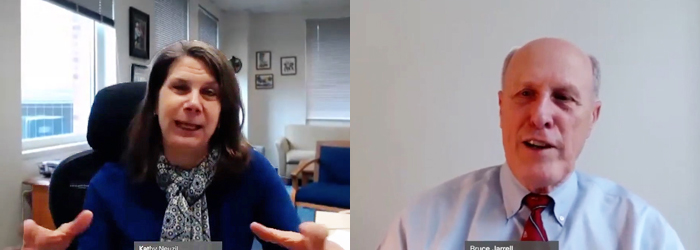May 2020
More than 200 viewers were already logged in and eager to watch the May 14 edition of Virtual Face to Face with Dr. Bruce Jarrell even before the guest joined the event. Kathleen Neuzil, MD, MPH, director of the University of Maryland, Baltimore's (UMB) Center for Vaccine Development and Global Health (CVD), is at the center of the global effort to find a vaccine to prevent COVID-19.
More than 100 vaccine candidates are at some stage of development around the world. A dozen are already in clinical trials or will be in the next month or so. One of the leaders, under development by a team at Oxford University, is already in phase 2 trials, and the team there says a vaccine could be ready by fall. Cambridge-based Moderna Therapeutics recently announced it had received Food and Drug Administration fast-track designation for its vaccine candidate, calling phase 2 trials “imminent,” with planning underway for a phase 3 trial as early as this summer.

Drs. Kathleen Neuzil and Bruce Jarrell speak about vaccine development on “Virtual Face to Face with Dr. Bruce Jarrell.”
A day earlier, on May 4, CVD became the first in the United States to begin testing four variations of a COVID-19 vaccine candidate developed by Pfizer and Germany-based BioNTech. Like the Moderna candidate, these candidates use messenger RNA (mRNA), rather than an inactivated piece of the actual virus, to spark an immune system response and the production of antibodies to fight the virus.
Cognizant of the question on everyone’s mind, the program’s host, UMB Interim President Bruce E. Jarrell, MD, FACS, wasted no time. “So what I’ll do is get right down to the brass tacks here,” he started off. “Tell us the answer to this question, when will we have a vaccine?”
“Of course, the answer is, ‘We don’t know,’ ” Neuzil replied. “We’re working in an unprecedented time here, where the first Phase 1 [vaccine trial] in the United States, for example, which was the Moderna mRNA vaccine, that trial went into phase 1 within two months of having the virus sequenced. So while it seems slow to us who are anxious to get back to our regular activities, again, these timelines are unprecedented.”
The bottom line: “We may see a vaccine by the end of 2020,” Neuzil said. “If we do, it will likely be limited quantities. We would love to see three or four vaccines on the market by the first half of 2021 to really be able to supply the world.”
“This vaccine that you’re trialing is somewhat of a new approach with the messenger RNA. Would you explain to us: Why is that different? Is it better, is it known, and what do you expect out of your trial?” Jarrell asked.
“Ordinarily when we get vaccines, we either get a weak live virus vaccine — that’s what measles is; mumps, rubella are the same — or we get a protein vaccine or maybe a piece of a bacteria or a virus. Hepatitus B is simply the surface antigen, so it’s a protein vaccine. Most influenza vaccines are protein vaccines,” Neuzil replied. “Where this differs is rather than giving that spike protein, the SARS-CoV-2 spike protein, we’re instead injecting the sequence, the genetic code for that, and our own cells are making that protein.” Neuzil went on to explain that an mRNA vaccine can be scaled up and manufactured faster, and at a lower cost, than traditional vaccines.
“The other advantage is your body is seeing this more as a virus is seen. That’s what happens: The virus gets into our cells, takes over our machinery, and our cells make the virus, and so if your body is seeing it in the same way, then the idea is that perhaps the immune response will be better or more appropriate for a vaccine given in this way.”
Questions from the audience ran the gamut from the non-scientific — such as “How do I participate in a trial?” and “Is the virus less transmissible outdoors than inside?” — to more detailed scientific questions about the specific tests used in Neuzil’s lab.
Some others, like James Bao, were looking for more immediate guidance regarding the COVID-19 pandemic. “The stay-at-home order will be lifted Friday evening by Gov. Larry Hogan. What should we do next and what would be best for UMB?” he asked.
“We know that there’s always a tradeoff. We know that elective procedures have been put off. We know very unfortunately that children are not going in for their routine vaccinations, even though they should be. We know that other health outcomes really depend on us getting out into society safely. We know the economy is devastated. This is all a balance,” Neuzil said. “We should be staying home as much as we can. Yes, this is gradual, but the threat is still there, the virus is still there. We’re having to do this in a deliberate and very careful way.”
Jarrell offered more insight into how the University plans to move forward. “My priority is to increase — and when I say increase, I don’t mean turn the switch from off to on. I mean gradually increase, getting people back in their basic science labs,” he said. “After all, what’s the essence of UMB? The essence is that we have students and faculty taking care of patients, we have attorneys and social workers working with clients for social justice. And getting back in that mode of thinking in some restrained manner is a priority.”
Watch the entire Virtual Face to Face with Dr. Bruce Jarrell by following the link at the top of the page.
For individuals interested in participating in this important vaccine trial, call 410-706-6156, text COVID19Vaccine to #555888, email clintrial@som.umaryland.edu, or visit this CVD webpage.
Search UMB News
Sign up for UMB Alerts.



